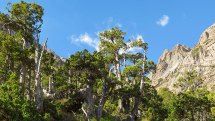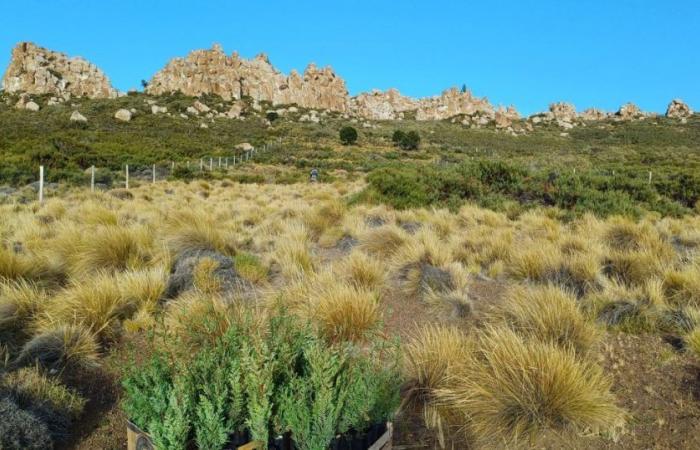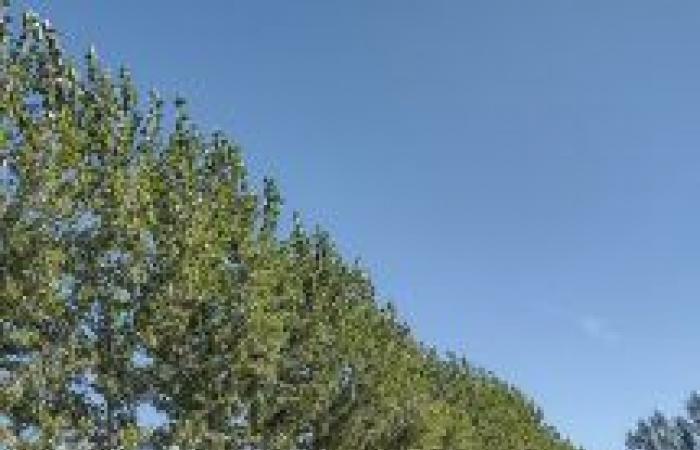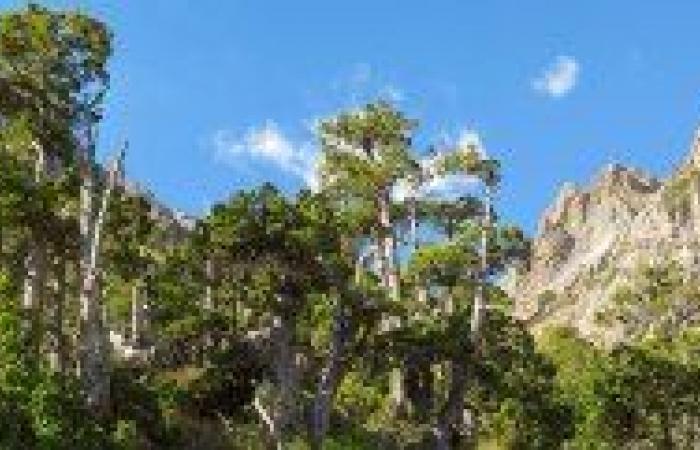The project seeks to contribute to the conservation of the genetic resources of a population of Cordillera cypress (Austrocedrus chilensis) of a relict nature that are found in the north of the province of Neuquén – in the Riscos Bayos area, near Loncopué –, and which contains a very particular genetic pool. Through the planting of 56 small trees produced with seeds from the population itself, natural regeneration was assisted as an in situ conservation strategy.
Mario Pastorino –Researcher from the Forest Genetics Group of the INTA of Bariloche– explained: “We We have a bank of Cordillera cypress seeds as a safeguard for the genetic resources of the species.and we kept seeds from Riscos Bayos at the time of joining the project,” added the researcher.
The seeds had been harvested in 2002, with that seed the production of plants began immediately in the experimental forest nursery of the INTA Bariloche. This process took three years – from 2021 to 2024 – and finally, on April 17, the plantation was carried out on the fence installed by the Neuquén Forestry Department.
The cypress population of Riscos Bayos has a relictual character, that is, it is a small portion of forest that survived the last glaciations. At the same time, it is in a very harsh environmental situation, with 246 millimeters of annual precipitation.
“We have a Cordillera cypress seed bank as a safeguard for the genetic resources of the species.”
Mario Pastorino –Researcher of the Forest Genetics Group of the INTA of Bariloche–.
“We have not observed natural regeneration in more than 20 years, until the ’90s the wood from that small cypress forest was used for the extraction of poles and firewood – stumps remain as testimony to this. As they are currently found within livestock fields in the region, if there is no active intervention with plantations, it is possible that the population is heading towards extinction.”, Pastorino pointed out.
The conservation of natural resources requires lasting public policies. For this reason, the General Directorate of Forest Resources of the Province of Neuquén initiated the “Plan for Restoration of Degraded Areas” project and called in 2021 the Forest Genetics Group of the INTA of Bariloche to participate in it.
“The first difficulty in planting local genetics was the availability of seeds from the trees in the Riscos Bayos forest, since not every year they give enough seeds.. It is at this point that INTA’s participation became important, since at the INTA Bariloche Agricultural Experimental Station we have an active Cordillera cypress seed bank that had Riscos Bayos seeds harvested in 2002,” explained Pastorino.
“We have not observed natural regeneration in more than 20 years, until the ’90s the wood from that small cypress forest was used for the extraction of poles and firewood.”
Mario Pastorino –Researcher of the Forest Genetics Group of the INTA of Bariloche–.
To preserve the seeds, it is necessary to air them, clean them of impurities, and dry them naturally in a dry environment. for a couple of weeks, place them correctly labeled in airtight bags and store them in the freezer.
The seed bank is a safekeeping of genetic material of certified origin. It is an ex situ conservation method, which in this case served to carry out an in situ conservation action, that is, in the natural place where the population to be conserved grows. Beyond this unusual case, INTA tries to ensure the availability of seeds of certified origin to nurseries that require them for the production of seedlings.
The good preservation of these seeds allowed them to germinate in 2021and then raise the seedlings for three years in the experimental nursery of INTA Bariloche.
“Twenty-two years later, the particular genes of Riscos Bayos returned home.”
Mario Pastorino –Researcher of the Forest Genetics Group of INTA Bariloche–.
In April, technicians from both agencies planted 56 cypress trees of local genetics in a closed area of just under one hectare next to the natural forest of Riscos Bayos. “Twenty-two years later, the unique genes of Riscos Bayos returned home”said Pastorino.
Likewise, the INTA research team publishes a bulletin of native forest seeds every year in which it offers for sale the batches of seeds that are harvested.. “In recent years we have played a relevant role in the restoration projects that have been carried out in the region to recover the forests that have been lost due to forest fires,” concluded the researcher.









